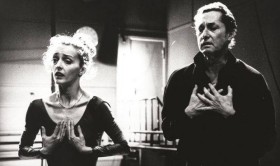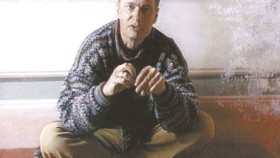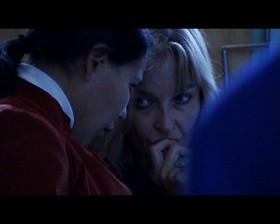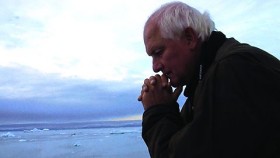Og så går de i gang med at lave filmen. Filmens kurve bliver som Kirkebys kurve, den må skabe et nulpunkt, tror jeg det er han siger, og så må den med ham bevæge sig frem gennem en række af stemninger, som bliver til filmens afsnit. Sådan aftaler de konstruktionen, så enkel er den, de to erfarne ved hvad de gør. ”Jeg magter det ikke helt, det ved jeg godt, det må være som det er,” udbryder han et sted i gang med et billede, et værk trods alt, og klaverkoncerten triumferer…
Her sidder Per Kirkeby i et højloftet værelse i Slottet i Italien, i Anne Wivels film fra 2000. Citatet henviser imidlertid til den næste film, Anne Wivel lavede med med Per Kirkeby, Mand falder(2015). De to film er så nøje i slægt med hinanden. Og der er jo disse majdage 2018 anledning til at gense disse to biografiske filmesseys og andre der er lavet om Kirkeby og hans arbejder, Jesper Jargils Per Kirkeby – Vinterbillede (1996), Pernille Bech Christensen: Pers metode (2008) og Steen Møller Rasmussens Richard Winthers hus (2009), og for mig også til her at samle, hvad vi på Filmkommentaren har skrevet om denne række film, Per Kirkeby sådan medvirker i eller skildres i, og så væsentligt, nogle af de film han selv har lavet eller været med til at lave. Han gjorde dem alle i slægt med hinanden ved at være så meget til stede som han altid var. (ABN 10. maj 2018)
DA MYNDIGHEDERNE SAGDE STOP (Aqqaluk Lynge og Per Kirkeby, 1972)
Jeg blev allerede ved første gennemsyn ekstra opmærksom ved titlen på en af Sumes smukke sange, Qullissat. Den by kender jeg fra noget ondt i noget godt. Her i denne fremmede verden, denne fremmede musik, dette fremmede sprog, en stolt kultur, som jeg ved, jeg er så forpligtet på, her er der pludselig noget, jeg ved lidt om i forvejen. Denne smukke, ulykkelige by er en del af også min erindring, min fortid. Det er fordi Aqqaluk Lynges og Per Kirkebys film har levet i mig, siden jeg så den i 1972 første gang, og formet mit billede af det grønlandske.
Min yndlingsscene fra Da myndighederne sagde stop, som filmen hedder, indgår et sted i arkivmaterialet i Inuk Silis Høeghs Sume, 2014. Det er Teit Jørgensens tætte indendørs optagelse med en mand fra byen, som, mens han ryger en cigaret og hans barn lytter med, fortæller om situationen. Byen er nedlagt, alle skal flyttes fra deres huse til, for en stor del tror jeg det var, lejligheder i Nuuks boligblokke. Jeg husker, at styrken ved den scene er dens længde, samværets længde, barnet som giver sig til at lege med røgen fra cigaretten. Den fortælling, den scene, er meget lang, måske er det en grønlandsk æstetik, at fortællinger er langsomme ligesom sproget? (Det burde jeg finde ud af). Udsagnet består af det, manden fortæller og meget af det, har jeg faktisk glemt, men filmscenens øvrige fortælling, for eksempel om stemningen i det hjem, livsrytmen der, trygheden til nu, lyset og farverne står tydeligt for mig…

Fotografi: Teit Jørgensen: Fra Qullissat
ASGER JORN (Per Kirkeby 1977)
Som regel kan jeg ikke lide at læse, hvad instruktørerne mener om deres film, hvordan de udlægger deres film. Det minder mig så meget om facitliste. Og at se film er jo ikke at løse regneopgave, slet ikke at nå frem til det eneste gyldige resultat. Men der er undtagelser, der er for eksempel Bang Carlsen og Leth og Bergman. Og der er Ada Bligaard Søby. Og så er der Per Kirkeby. Når jeg læser deres tekster om deres læsninger og gensyn med egne film (Bergmans Billeder frem for noget) eller deres synopser (Bligaard Søbys tænker jeg på, men hvor er det nu man finder dem?) så sker der det, at teksterne i stedet for at afrunde mit arbejde med filmene – nå det var så det, så lukker vi den bog – udvider og forlænger mit liv med filmene. Jeg får lyst til og brug for at se dem igen. Sådan er det i høj grad med Per Kirkeby. Lad mig derfor begynde gensynet på Filmcentralen med Asger Jorn (1977), begynde med hans frygtindgydende tekst Jorn – udvortes (1995), som bare skal læses (min absolutte anbefaling) og så hans elegante lille essay om fiktion Hvad skal man egentlig med kunstnere på film? (1995), hvor jeg her simpelthen citerer hele stykket om Asger Jorn:
”Fiktion. Da jeg lavede min film om Asger Jorn var det mit udgangspunkt. Jorn var død, jeg havde aldrig mødt ham, men han havde været meget nærværende i mit kunstnerliv. Som frastødning og tiltrækning, en fiktion i mit liv. Og der var ikke andre kilder end efterladenskaberne, reportagen var udelukket. Så filmens fiktion var rekonstruktionen af en figur, et liv, bestemt af efterladenskaber og mine spørgsmål. Derfor blev det først og fremmest en film der handler om valg og hvorfor i et liv i en tid som måske var anderledes. Om valgenes mulige suverænitet og mulige uundgåelighed og melankoli. Denne fiktion, denne handlingsgang, skulle opleves som en historie i sig selv, uden legitimering i værkernes berømmelse.
Så jeg viste ikke et eneste rigtigt maleri i filmen. Et forhold de færreste faktisk lægger mærke til. Et maleri er ikke til filmens tid, det er altid snyd og bedrag, når kameraet søger rundt og zoomer ind i en eftergørelse af se-processen. Og den alvidende, belærende speakerkommentar var også udelukket. I stedet benyttede jeg Jorns egne tekster, ofte uden direkte forståelsesmæssigt belæg, men mere efter en intuitivt fornemmet ”stemning”. Den må nemlig meddele sig, som tilskuer har man heller ikke mulighed for at kontrollere skriftens opbygning af argumenter.
Jorn var en så stor kunstner og en så afgørende figur at der ikke var noget behov for en heltemytologisering. Det forbød hans format. Og jeg var så at sige vaccineret mod den udvej fordi jeg søgte at forstå nogle ting der også for mig selv var af afgørende betydning. Og så var han altså væk. Men det var Wilhelm Freddie (1971) ikke. Så der var metoden den modsatte: Kun personen var i billedet, med sin egen fiktion…”
Og her bliver jeg nødt til indtrængende at bede Filmcentralen inddrage den film også, i et dejligt voksende udvalg af Kirkebys film, som lige nu tillige omfatter Geologi er det egentlig videnskab? (1980) og Ekspeditionen (1988). Det her må fortsætte.
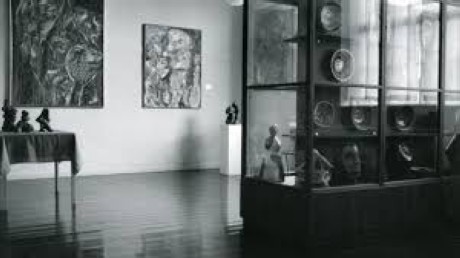
Teit Jørgensen, still til Asger Jorn
SANCT HANSAFTEN-SPIL (Jørgen Leth og Per Kirkeby 1979)
Jeg lærte i skolen, at Digte 1803 er en stor bog, måske den største i dette dengang nye århundrede, som vi er nogle, der aldrig rigtigt har forladt. Jeg hørte om samtalen med Steffens og jeg lærte Guldhornene udenad, det skulle vi. Og jeg lyttede efter, når Reumert læste digtet i radioen med musik til. Det blev en del af mig. Men jeg forstod det ikke. Først nu tror jeg, at jeg forstår. Lidt.
Tænk, at det er Jørgen Leth og Per Kirkeby – som i mellemtiden har betydet så meget for mig – og de kongelige skuespillere, som omsider (jeg så aldig tv-produktionen, og havde dengang i 79 bestemt ikke kunnet tage den ind..) at de viser mig, hvordan og hvorfor, den bog er stor. Og gør min dansklærers arbejde færdigt. Det var Thure Munkholms korte analyse, som bragte mig på sporet. Bare sætningen: “… Oehlenschlägers sprog, der her toner frem i al dets overvældende skønhed og metriske vidskab.” Altså! Metriske vildskab…
Og blide smerte: “… Jeg har jo alt elsket og levet!” Synger Maria ved klaveret, og Konen siger: “Deres Stemme har dog en herlig Klang. / Hvad hedder den Arie? / Maria svarer: Teklas Sang. / Den er oversat efter tydsk Poesi / til Weyses deilige Melodie.” Og jeg tilføjer: og Henning Christiansens gribende melodi til jødedrengens sang: “… Kommer at kiöbe, kommer at kiöbe! / Röde, gule, grönne og blaa i Fleng! / Jeg er en god lille Jödedreng!” Og Frits Helmuths fortælling om liden Kirsten: “… I gamle, længst forsvundne Tid / der var en deilig Pige..” Og Ove Sprogøes blinde mand: “Skaffer mig min Fiol igien, / at jeg kan tolke min stumme Smerte.”
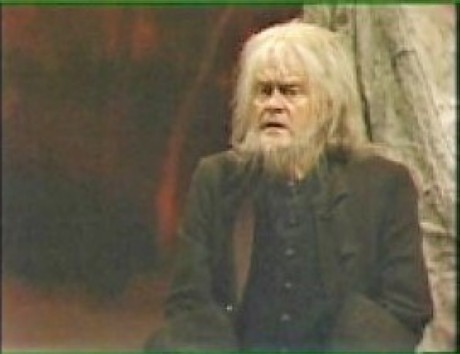
Alt dette ustandseligt afbrudt af den fineste ironi og klassiske lystighed: “De Gravhöie skulde Fanden flytte! / De staae her og giör ikke den mindste Nytte.” Tekstens første og berømte chok.

Institutionen Leth og Kirkeby og Christiansen har med hele holdet anvendt dette tydelige set-up fra digteren og omsat det i tv’s letteste og simpleste greb og gjort det til noget så enestående som tv-kunst af munter alvor.
GEOLOGI ER DET EGENTLIG VIDENSKAB? (Per Kirkeby 1980)
Titlens provokation har siddet fast i mig, siden jeg så filmen ved dens fremkomst. Det er for mig at gribe tilbage i mit liv og se begyndelsen til den kunstopfattelse, den videnskabsforståelse, som jeg orienterer mig med nu. Per Kirkeby er geolog, med istiden som speciale tror jeg nok, og så er det da en udfordring, når han et sted i filmen stilfærdigt siger, at istiden er en antagelse, en omvæltning for en skolelærer og nybegyndt museumsmand, som kommer lige fra geografilokalet og Axel Schous Danske Atlas, et vidunderligt værk, som i imponerende kort og smukke rekonstruktionstegninger forklarer sammenhængen mellem isrande, tunneldale og hovedstilstandslinje og det danske landskab med bakkeøer, moræner og tunneldale. Og jeg troede at dette alt sammen var fakta og bare skulle læres. En antagelse siger han så, kvartærgeologen! Jorden gyngede, måske var der helt andre forklaringer, geologi var ikke længere noget, der var dernede eller dengang, men inde i hovedet på en videnskabsmand, en tænker, altså en mulighed, en blandt flere, måtte jeg tro.
Jeg var dog forberedt. Det var begyndt for mig med Flyvende Blade (1974), som jeg nok læste fire-fem år tidligere. Jeg havde først været forundret, blev så fascineret og hurtigt optaget af denne særegne meget personlige blanding af dagbog, notater, breve, biografiske studier, erindringsfragmenter. En essayistik ud over alle de litterære grænser, jeg til da havde mødt. Sådan var også filmene, grænseløse, ustyrlige og skarptskårne med en fast hånd.
Per Kirkeby skriver om nogle af dem i 1995 i en tekst om kunstnere på film, han har lavet film om Asger Jorn og Wilhelm Freddie, dem skriver han om, Jornfilmen er fiktion i instruktørens liv, og Freddiefilmen er en film med den medvirkende malers egen fiktion, og så om den her film: ”… Geologi – er det egentlig videnskab? er en stump selvbiografi. Det kan man naturligvis i en vis forstand sige om alle en kunstners film, men i denne film er det et direkte motiv. Filmen opsøger et landskab og forsøger at genskabe et miljø i videste forstand, som var afgørende for kunstneren som ungt menneske. Men fiktionen er jo at det drejer sig om i en undervisningsfilm. Og hvad så?” Jeg prøver at læse digtet i stedet for fiktion og tror, jeg forstår det lidt bedre.
Og hurra, Per Kirkebys filmarbejde kan nu delvist, efterhånden vel komplet, ses på Filmcentralen. Herefter kan jeg vende tilbage til basis, her til én af søjlefødderne for min langsomme forståelse af, hvad film egentlig er for noget.
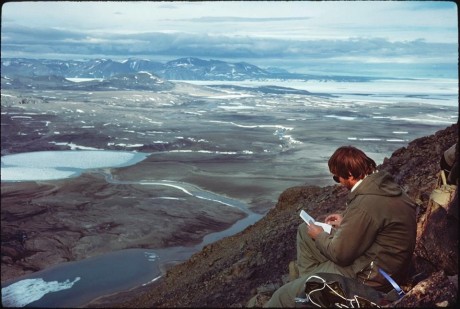
Still: Teit Jørgensen: Per Kirkeby i Pearyland
EKSPEDITIONEN (Per Kirkeby 1988)
Jeg fortsætter mine gensyn med Per Kirkebys film, som så lykkeligt er dukket op på Filmcentralen. Nu altså Ekspeditionen (1988), som vist nok aldrig tidligere har været i distribution, men som jeg så sært kender alligevel. Noget af materialet er optaget, da Kirkeby og Teit Jørgensen lavede Geologi – er det egentlig videnskab?, 1980.
”Det er om Eigil og mig og Pearyland” siger stemmen. Om det handler den varde, som blev rejst af dem i landskabet der. Forstår jeg, da jeg ser den senere. Det var sommeren 1963, han var med på Eigils ekspedition, og det fortæller fortællestemmen sådan lige ud ad vejen, og stemmen er Per Kirkeby, det kan jeg jo høre, og Eigil er Eigil Knuth, det ved jeg. Billederne er fotografier, stills, og de er sært slørede og gamle, det er arkivstof, ja, men helt umanipuleret, upoleret og ikke på nogen måde strammet op. Så fortæller fortællestemmen, altså Kirkeby, at han nu, han er i gang med den her film, må han erklære, at han har mistet lysten til det filmiske, at han vil fortælle om denne personligt skelsættende begivenhed, ekspeditionen i sit liv, som i hans sind vokser som drøm og forestilling og gennemtænkning til hele mytologien om ekspeditionerne i dette grønlandske landskab, hvor døden får sin ikke fortrængte plads, så livet bliver til fylde, det vil han fortælle om i en lysbilledserie. Og jeg forstår, at Teit Jørgensen er sat til at filme lysbillederne, mens Kirkeby viser dem med sit lysbilledapparat på lærredet og ind imellem med sin finger peger på en bestemt linje i det viste landskab, noget, han vil pointere, som han derefter i sit store værk, akvarellerne og malerierne atter og atter har pointeret.
Og så med ét forsvinder stemmen, og der bliver stille, ikke klodset stille som et lydhul, nej hensynsfuldt stille som ønsket: se nu på de her billeder! Og jeg ser og ser og tror, jeg forstår det ufortællelige og bliver rørt over, at han ved, jeg også har det i mig, indtænker alt det, han ved, jeg ved, alt det, jeg har set og læst. Og netop som det er klart for mig, hvad det er, får jeg belønningen, Hans Andersen (ved jeg senere fra et tekstskilt) spiller tuba, det er filmmusik. Af Henning Christiansen. Kan jeg gå ud fra som selvfølge.
Det kan godt være, at det er en forudsætning for, at jeg opfatter den intense skønhed i Kirkebys film (ikke kun i den, i mange af dem, måske dem alle), at jeg ved lidt om baggrunden for eksempel billedsidens radikalitet. Manden er jo maler, og han mener noget med billederne, de er ikke tilfældige eller sjuskede, som jeg først kunne mene, så de kan selvfølgelig ikke uden videre afvises. Men det er for mig nødvendigt at studere deres forudsætninger, som er en helt anden æstetik end den, jeg er vænnet til og til dels skolet i. Det har hjulpet mig meget at læse, hvad han skriver om det. Som nu her om Teit Jørgensens fotografi (i det hele taget), som han beundrer, tilbage i december 1976 skriver han om kvaliteten af de mere nøgterne kompositioner, der afspejler en accept af ”procesessens almindelighed”:
”… Forstår fotografen dette, bliver hans billeder hverken platte eller demonstrativt tilbydende (…). Billederne får den klare redegørelse for udstrækninger og rum, figurer og størrelser, den rolige klarhed som bliver erindringens og stedernes magi. (…) Meget få fotografer når denne indsigt i simpelheden, de fleste frygter den faktisk og står på hovedet. (…) Men ud af den fotografiske dokumentation, denne simpelhed, vokser stemninger uden ord. Tænk det lader sig se. Teit Jørgensen er en dansk fotograf der har disse kvaliteter. Hans billeder er ikke demonstrative, men de viser at dette lader sig se. Hans billeder har denne rolige udstråling”
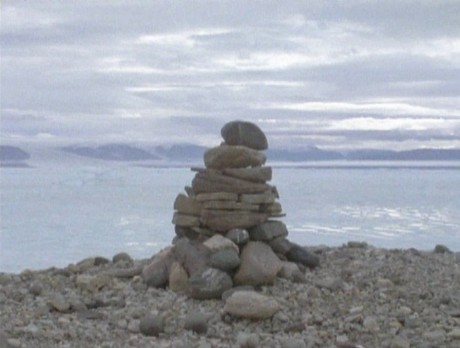
Still: Teit Jørgensen
DYREHAVEN DEN ROMANTISKE SKOV (Jørgen Leth og Per Kirkeby 1990)
I 1970 instruerede Per Kirkeby sammen med Jørgen Leth Dyrehaven, den romantiske skov og Henning Camre fotograferede.
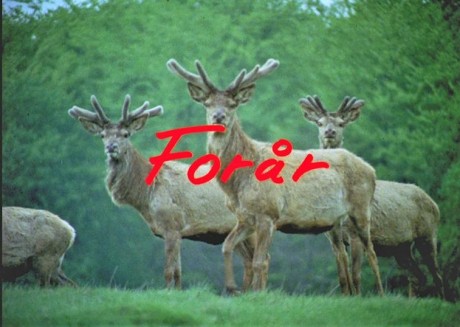
Still: Henning Camre.
Filmen er tilgængelig på dvd i Jørgen Leths bokssæt, og den er også særdeles vigtig i Kirkebys samlede værk, det understregedes allerede dengang ved en bemærkning af Hans-Jørgen Nielsen i hans anmeldelse i Information, 18. juni 1970 under overskriften En meget mærkelig film: “…Fotografen Henning Camre fejrer triumfer i disse dvælende farveorgier i harmonisk naturskønhed. Farvefilm har aldrig før været anvendt med en sådan artistisk følsomhed og teknisk overlegenhed i dansk filmproduktion. Men inden i og samtidig med disse banalt smukke og konventionelt romantiske billeder er der endnu en film. En metafilm om den umiddelbare naturfilm, der holder denne frem som en ren og skær historisk skrift. Den egentlige bedrift i så henseende er Per Kirkebys. Alle filmens billeder er totalt behersket af hans særlige måde at se på. Den er et af maleren Per Kirkebys hovedværker…”
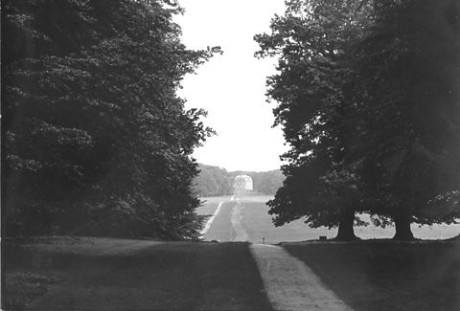
Still: Henning Camre
PER KIRKEBY – VINTERBILLEDE (Jesper Jargil 1996)
… Jeg begyndte med hans film om Kirkeby, Vinterbillede. Det var den aften jeg hørte at et nyt menighedsrådsflertal ville male Kirkebys loftdekoration i en eller anden kirke over og afbestille den planlagte altertavle. Den aften, hvor Rilke og Bjørnvig, Ransmayr og Rushdie omsider fik den europæiske kulturpris. Kirkebys kommentar i tv var afdæmpet og fuld af forståelse. Sådan går det når man laver noget anderledes og sender det til afstemning. Sådan går det hver gang. Sagde han, resigneret på den stærke facon, som lover et fast greb i en lang ende.
Man skal jo begynde et eller andet sted, og jeg og alle der ser Jargils film glemmer aldrig, hvor den store maler begynder det store billede. Kirkebys indre monolog kører som voice-over og gør mig rolig. Jeg skal nok komme igennem disse visuelle ændringer af det ene billede, filmen består af, komme igennem nogle gange umærkelige, andre gange chokerende stemningsskift. Hver gang forsigtigt lagt som overtoning.
Pludselig er Michael Werner på besøg, en anden gang ser vi lige Vibeke Windeløv. Begge er jo så betydningsfulde. Kunsthandleren og Kirkeby går omkring hinanden i det store atelier som tigre i bur. Konen og manden kysser hinanden. Venskab og familieliv foran det store billede, hvor tilværelsen males ind, lag på lag, så fortidens gule farve som en fundamental erindring ligger skjult af nutidens grå. Det er fuldstændigt spændende, faktisk blandt det mest spændende, jeg nogensinde har set på film.
For mig var gennem alle årene det vigtigste ved Kirkeby hans tekster. Fordi jeg kunne bruge dem umiddelbart som korrektiver til min omverdensforståelse. Hans malerier derimod var længe mysterier. Til for ganske nylig (1996, red.) faktisk. En lille introduktion, som William Gelius på kunstmuseet i Ribe havde skrevet til et enkelt billede på den store Kirkebyudstilling i sommer løste imidlertid op. Et lille stykke forbilledlig pædagogik på en fotokopieret side satte gang i mig. Ét for ét lod udstillingens billeder sig dirke op.
På samme måde er det en gave her at få en tekst til endnu et billede. Og Jargils film er en tekst. En på én gang storslået og kompliceret tekst i et lydefrit filmværks form og en helt enkel fremstilling. Om at male et billede frem og bryde ned igen. Strukturen er altid det som bliver tilbage i ruinen. Man forstår atter en bid af det romantiske projekt. En simpel fotokopi og en underskøn dokumentarfilm. To vigtige tekster til mig. Den første førte til udstillingens malerier, den anden til filmens billede.
Og herefter endnu en bekendelse: skulle jeg altid have ønsket at lave en film, var det denne. Jeg er misundelig og bevæget. Også jeg har det sådan, at jeg kan blive enormt rørt af billeder, kan også nærmest græde over at se et billede, for eksempel nænsomheden, den fortvivlede kraft.
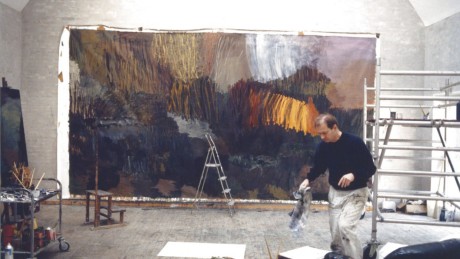
Still: Jesper Jargil
SLOTTET I ITALIEN (Anne Wivel 2000)
Det er her også Per Kirkeby, som spiller den store rolle som manden midt i livet, manden i krise. Som spiller rollen som sig selv. Filmen handler også om Anne Wivel og hendes filmkunst. I et interview engang sagde hun ”… Jeg ønsker at filme disse konflikter. Jeg synes ikke en konflikt er en privat ting, den kan deles med alle og enhver. Når jeg har fået de medvirkendes accept, er de altid meget villige, givende og åbne…” Og så fortalte hun om Giselle (1991), hvor balletmesteren Henning Kronstam kommer i en konflikt, som på mange måder minder om Per Kirkebys. Det er Anne Wivel, som i sin instruktion og med sit greb tilvejebringer disse usædvanlige dybder af forståelse, som måske også kommer bag på de to mænd.
Nu skildringen af maleren i det italienske slot. Lyden begynder før billedet. Det er fuglestemmer. Så ser vi malet murværk, brækkede nuancer i rødt og grønt. Og væggen har tydelige og betydningsfulde revner.
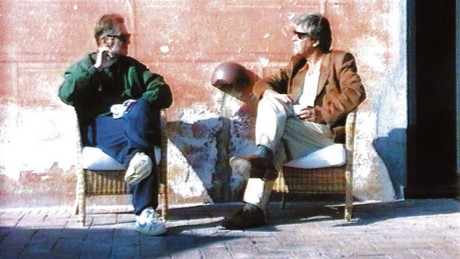
Og så pjattet mandesnak. De to mænd sidder og ler i et stort rum. Maleren og hans gæst. Instruktørens stemme høres, så vi fra nu ved, at hun også er til stede. Kvinden med kameraet hedder hun på forteksten. Man taler lettere, når man ved, det ikke skal bruges, det man siger, bemærker de to mænd, sikre på, at dette er en prøve. Og så kommer tavsheden, som den vigtige pause i dialogen, men ikke pause i filmens fortælling. Gæstens næste bemærkning er: ”Det skide kamera ser mere, end vi ser”. Kameraet afsøger nu loftet.
Så sidder maleren vrissen på briksen og siger, at indfald ikke kan gentages. Igen er han tavs. Tøver og siger, at han er forkølet og forvirret. Dagbogen er opgivet for første gang i 30 år. I tre årtier til nu har han bogført sit liv. Billedet viser, at bladene udenfor bevæger sig voldsomt i blæsten. Oliventræet vender den grå underside opad. De taler om farverne, som maleren altid vil bryde ned. Farver skal være præcise, ikke brilliante.
Så fortæller han om Vibeke. ”For dem, som stiger på romanen nu, så er hun min kone”, siger han. Og han fortæller om den skæbnesvangre begivenhed. Som har med huset, slottet, stedet og hende at gøre. Det handler altså om det gamle hus og rummene. Om to mænd og en kvinde, som filmer maleren og gæsten, hvis emner i hvert fald er seksualiteten og kønnet. Og arbejdet og tilstanden nu. Og om samværet dette sted. Som er kvindens sted og kærlighedens, måske.
Spørgsmålet stiller maleren til instruktøren: ”Er det sådan, det skal være? Alt det her pladder?” Hun svarer off: ”Jah…”, altså både ja og nej. Så fortæller maleren en anekdote fra Alma Mahlers selvbiografi. Da han er syg til sidst siger hun til ham, at når han bliver rask, skal de gå fra den åndelige kærlighed til den lidenskabelige. De skal begynde at røre ved hinanden, fortæller maleren. Jeg stiger på romanen her…
PERS METODE (Pernille Bech Christensen 2008)
Per Kirkeby og Poul Erik Tøjner mødtes før åbningen af udstillingen af Kirkebys værker nu og tilbageskuende tre dage i maj. Til en samtale. Deres samtale de tre dage er blevet til en smuk, klog og meget vigtig film. De to taler med hinanden om maleriets metode – som titlen så præcist angiver – og om alt det i arbejdet, i livet og i biografien, som er malet ind i billederne. Hvor det herefter er til stede, men skjult. Samtalen er yderst omhyggelig og særdeles åbenhjertig – men “om nogle ting taler man ikke”, som Kirkeby alvorlig udtrykker det. Der slutter samtalen og filmen.
Denne finhed af tøven og tilbageholdenhed hos Tøjner og Bech Christensen er deres films styrke. For det er i dette rum af opmærksom tryghed, at den store maler kommer ud i områder, som supplerer og uddyber alt det, vi ved fra Jesper Jargils film og fra Anne Wivels film, fra alt det, vi har læst i Kirkebys mange bøger. Er der mere at føje til? Kunne man spørge. Filmens svar er overbevisende: der var mere, og der er mere…
Bøje Lomholts to kameraer, et (farve) bevægeligt og et (sort/hvid) fikseret følger omhyggeligt bevægelserne i den balancerede samtale mellem de to, som kender hinanden indgående, og Pernille Bech Christensens klip føjer omhyggeligt lyttende på det eleganteste de forskellige tidspunkter og steder for optagelse og den åbenlyst fortsatte talen med hinanden sammen til ét langt ubrudt samvær, hvor klip midt i sætninger ikke afbryder, men fører til uddybning på uddybning af forståelsen af Kirkebys arbejde og metode.
For os her i Randers kan for eksempel et afsnit i filmen om den vandrette bjælke i en række værker føre til, at vi får nye forståelser af alterbilledet i Sct. Mortens Kirke, andre får læsningen af de billeder, de dagligt omgås, tilsvarende udvidet ved samtalen om at være ”den læsende kunstner” og ”den lærde maler”, som gennem sit værk har skabt en alternativ kulturhistorie.
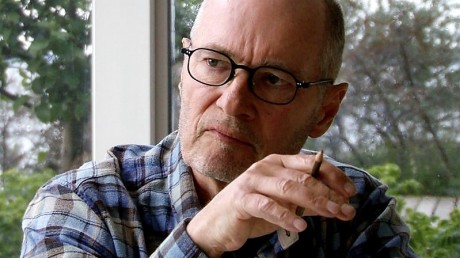
Still: Peter Bech
RICHARD WINTHERS HUS (Steen Møller Rasmussen 2009)
Endelig er Per Kirkeby kommet ind i det legendariske hus i Vindeby. Godt nok for sent til at træffe Richard Winther. Han er der ikke. Han er død. Men i tide til at møde hans værk i huset, billederne på vægge og lofter. Man er med på besøget i de kolde rum. Berørt af situationen som Kirkeby er det. Han havde sammen med John Hunov planlagt eller i hvert fald talt om at køre dertil. Men de kom aldrig af sted. Og så lagde Winther sig som Kirkeby udtrykker det. Mildt bebrejdende. Nu er huset tømt for de mange, mange ting, som før fyldte det. De er flyttet langt væk. Men billederne på pudset og betonen og brædderne er der endnu, og Kirkeby er tydeligt rørt og ærligt overbevist. Dette er stort. Det er ikke vitserne fra Gl. Holtegaard udstillingen. Dette er den gamle og alvorlige akademiker. Og det er i den historiske sammenhæng Picasso og Goya. Det er derimod ikke Matisse. Kirkeby forklarer præcist hvorfor og hvordan.
Steen Møller Rasmussen har begge sider af manden med på sit fotografi af maleren i kurvestolen med opsatshat. Både det vitsede og det akademisk/statuariske. Begge sider skildret i en tydelig alvor. Men filmen koncentrerer sig udelukkende om denne særlige storhed, som overrasker Kirkeby, fastholder den i Kirkebys tøvende uforsigtige fremstilling. Usentimentalt og klart i en reportage delt på tre fortællende og kommenterende medvirkende vidner, ud over Kirkeby keramikeren Grethe Bull Sarning og kunsthistorikeren Christian Vind. En tredelt reportage (tredelt i stil, indhold og emotionel egenart), som tager sig selv alvorlig som gennemført metode hos en fotograf, som tør tage reportagen på ordet: at fortælle det som det er – og på den måde som det der var.
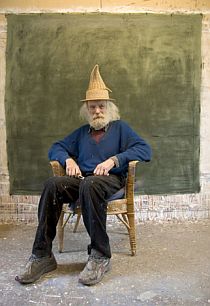
Fotografi: Steen Møller Rasmussen
MAND FALDER (Anne Wivel 2015)
Det begynder stille og roligt med Anne Wivels stemme, som nænsomt fra bag et fortæppe af Per Kirkeby lærreder ganske kort fortæller den personlige baggrund for filmen: Kirkeby er en forårsdag 2013 faldet ned ad en trappe, har fået en hjerneskade, som alvorligt forstyrrer hans syn og hans bevægelighed, han kan ikke male, han kan ikke gå. Hun kan omsider besøge ham og aftenen før ringer hans hustru og siger, at han gerne vil at Anne Wivel tager sit kamera med. Hun bevæges, hun har ikke brugt kameraet siden hendes mand to år tidligere faldt og slog hovedet og kort efter døde, og hendes dæmpede stemme fortsætter herefter med hendes ja, dette fortrolige og ægte ja til sætningerne fra maleren og vennen, fortsætter og fortsætter. Anne Wivel er i den her film til stede hele tiden, i optagelserne, i samværet som vokser til filmværket som Per Kirkeby vel sådan har ønsket de endnu en gang kunne lave sammen.
Titelsekvensen klipper til atelieret, Kirkeby sidder og taler med kameraet og lidt med sin hjælper som også er der, og lidt med hustruen som også er der, der er hele tiden mennesker omkring ham, og han taler med kameraet og med Anne Wivel bag det, taler om situationen: jeg kan ikke gå, jeg kan ikke male, jeg kan ikke se, jeg kan ikke genkende ansigter. Det er ærgerligt siger hun, det er godt nok surt siger han og så går de i gang med at lave filmen. Filmens kurve bliver som Kirkebys kurve, den må skabe et nulpunkt, tror jeg det er han siger, og så må den med ham bevæge sig frem gennem en række af stemninger, som bliver til filmens afsnit. Sådan aftaler de konstruktionen, så enkel er den, de to erfarne ved hvad de gør. ”Jeg magter det ikke helt, det ved jeg godt, det må være som det er,” udbryder han et sted i gang med et billede, et værk trods alt, og klaverkoncerten triumferer ved de kunstneriske sejre, ved indsigtens gennembrud.
Per Kirkeby tegner, Anne Wivel filmer. De arbejder sammen, nu ved farvetuberne og så er vi ved lærredet, ”jeg mister orienteringen”, siger han, og han kigger på lærredet, ”… det er som et tapet”. ”Du er hård, Per” siger hun. Sådan taler de med hinanden, mens de arbejder på værkerne, arbejder sig gennem scenerne, stemningerne. Med Minik Rosing på Louisiana, Kirkeby kan ikke huske, ”det er så mærkeligt ikke at kunne genkende sine egne billeder”, siger han. Så hjemme i villaen i Hellerup, træning i et få synet på plads igen. Samtalen med Anne Wivel er så enkel, så kortfattet, så fin: ”Er du ked af det?” ”Ja.” ”Det kan jeg godt forstå”. En anstrengende rejse til Aars til afsløring af en stor skulptur, en tilsvarende nøgtern samtale med dronning Margrethe. Hjemme i Hellerup igen, han modellerer i lille format. Alligevel: ”Jeg magter det ikke helt. Det ved jeg godt.” Og så befriende fast: ”Det må være som det er.” Samtalen med Anne Wivel kommer til at handle om tålmodighed og dovenskab. Han vil godt lære tålmodighed men kan ikke med dovenskab. Hun synes han skal give sig hen i den. Nye dybe indsigter kan det føre til. ”Dem er jeg ikke stødt på”, replicerer han tørt. Og så alligevel, jo, han er stødt på kærligheden og på evnen til at tilgive ”og sådan noget det har aldrig været min stærke side”. Det virker måske banalt i mit referat, i filmen er det aldeles ægte og vigtigt og meget smukt. Og han taler spontant om hustruen og spørger om det ikke også var sådan med Svend, hendes mand? Og jeg lukkes som en generøsitet ind i et nyt rum.
Han tegner pludseligt energisk med et stykke oliekridt, han tegner faldet på trappen, tegner først trappen, ”en rigtig Kirkeby-trappe”, siger han og både Anne Wivels kamera og jeg kan se at det er det netop, se det langt tilbage i hans værk. Og han tegner med sikre, sikre bevægelser faldet og senere skrammerne og så det der neden for trappen. En tegning bliver til og koncertens orkesterstemme triumferer. Han tegner videre på et nyt ark og hun siger: ”Det er skønt, Per. Du skal blive ved…”
Der kommer nye afsnit, nye stemninger, nedture mod nulpunktet og flere og flere sejre, mange hos de trofaste kolleger i det grafiske værksted.
Anne Wivel har gemt en vældig overraskelse til sidst, jeg bliver bestemt overrasket og ved eftertanke på en måde ikke: jeg er igen med Anne Wivel og Per Kirkeby på slottet i Italien, igen på det sted efter 15 år og jeg er tryg. Landskabet i bjergene er der, den ærværdige kolossale bygning ligger der, de gamle fresker så åbenbart øget siden sidst med Kirkebys talrige nye sidder der på væggene. Vennerne og kollegerne er med, lærrederne står parat i atelieret. Men atelieret ligger øverst ved slutningen af en høj stenbygget trappe, en hel del vanskeligere at gå på end trappen til træning hos fysioterapeuten, også fysisk vanskeligere, men filmen handler om den anden vanskelighed, trappens begivenhed som motiv ”den rigtige kirkebyske trappe” og senere er motivet Sebastian bundet til træet døende med de mange pile i kroppen, men jeg ved at en kvinde vil pleje hans mange sår og han vil komme sig. For en tid.
Som hos Platon er der indlagt taler i fremstillingen. Der er faktisk indlagt to. Jeg ser det bliver til tre. En tredjedel inde i filmen taler ved en fest på et galleri Hans Edvard Nørregård-Nielsen. Det er en tale om det danske og om to digtere, Thøger Larsen og Poul Martin Møller. I sin stemmes myndighed viser han digtlinjernes lighed med træk i Kirkebys malerkunst, lighed i en særlig danskhed og i en udødelighed. Ved en anden sammenkomst, det er i huset på Læsø, læser Peter Laugesen et digt og det er et digt om kunstnerisk størrelse og sindets vejrlig: ”… Det format, der kan rumme de drejende lavtryk, de dybe huller, hvorfra vindene kommer / de nedre og øvre passater, monsuner, kulinger, storme og orkaner. / Drømmenes skypumper.” Og Anne Wivel laver på en måde sin film som endnu en tale om at fremstille dyb, indsigtsfuld kunst i trodsigt mod på trods af, en hjernes skade.
Et tidsrum i Per Kirkebys liv hedder filmens undertitel på plakaten. Tidsrum… Det er et smukt ord det danske sprog aldrig må miste. Tidsrum, tid og rum, tid i rum, rum tid som betyder rummelig tid, omfangsrig tid, tilstrækkellig tid. Her er tid nok. Sådan er Anne Wivels nye films vigtige erkendelse af livet, menneskets liv. Uanset det tidsbundne i filmens biografiske udgangspunkt vil Anne Wivels Mand falder blive stående længe som umisteligt hovedværk i dansk film, endnu et hovedværk fra hendes hånd, endnu et værk om mandigheden og Eros’ stadige jagt på skønheden.

NOTER
Aqqaluk Lynge og Per Kirkeby: Da myndighederne sagde stop, 1972.
Distribution: http://filmcentralen.dk/museum/danmark-paa-film/film/da-myndighederne-sagde-stop (streaming)
Tekst: ABN, del af blogindlæg om Inuk Silis Høegh: Sume (2014), 20. november 2014.
Per Kirkeby: Asger Jorn, Danmark 1977, 62 min.
DIstribution: http://filmcentralen.dk/alle/film/asger-jorn (streaming)
Manuskript: Per Kirkeby, fotografi: Teit Jørgensen, klip: Grete Møldrup, musik: Asger Jorn, Jean Dubuffet, fortællerstemme: Morten Grunwald, produktion: Vibeke Windeløv / Kraka Film, distribution: Filmstriben. Litt.: Per Kirkeby: Fisters klumme (1995), de to Kirkebytekster findes her. Tekst: ABN, blogindlæg 12. august 2013.
Jørgen Leth og Per Kirkeby: Sanct Hansaften-Spil, 1979
Distribution: Findes i DVD-udgaven The Jørgen Leth Collection 19-21, Det Danske Filminstitut, 2008. Litt./link: Lars Morell: Installations in Space and Architectonic Scenery, http://pov.imv.au.dk/Issue_04/section_1/artc3A.html med en grundig beskrivelse af Per Kirkebys scenografi. (ABN, blogindlæg 20.september 2008)
Geologi, er det egentlig videnskab? Danmark 1980, 41 min.
Distribution: http://filmcentralen.dk/grundskolen/film/geologi-er-det-egentlig-videnskab (streaming)
Manuskript: Per Kirkeby, fotografi: Teit Jørgensen, klip: Grete Møldrup, musik: Henning Christiansen, fortællerstemme: Per Kirkeby, produktion: Vibeke Windeløv / Kraka Film, distribution: Filmstriben. Litt.: Per Kirkeby: Hvad skal man egentlig med kunstnere på film? i Fisters klumme, 1995 og Flyvende Blade, 1974. Tekst: ABN, blogindlæg 12. juli 1913.
Ekspeditionen, Danmark 1988, 31 min.
Distribution: http://filmcentralen.dk/grundskolen/film/ekspeditionen (streaming)
Manuskript: Per Kirkeby, fotografi: Teit Jørgensen, klip: Grete Møldrup, musik: Henning Christiansen, fortællerstemme: Per Kirkeby, produktion: Vibeke Windeløv / Kraka Film, distribution: Filmstriben. Litt.: Per Kirkeby: Ekspeditionerne i Fisters klumme, 1995. Per Kirkeby citatet er fra teksten Fotografen i Victor B. Andersen’s Maskinfabrik, december 1976, side 86. Her citeret via en hjemmeside (uden årstal) om Teit Jørgensens separatudstilling Snapshots & Stills i Galleri Tom Christoffersen. Tekst: ABN, blogindlæg 13. juli 1913.
Jørgen Leth og Per Kirkeby: Dyrehaven den romantiske skov,1990
Distribution: The Jørgen Leth Collection, Det danske Filminstitut, 2007ff. Jørgen Leths filmværk på dvd samlet i seks bokssæt.
Citatet er fra Anne Hejlskov Larsens Per Kirkebys malerier 1957-1977 (2002), hvor hun blandt alt det meget andet har skrevet en komplet oversigt over Kirkebys film. Litt.: Kyndig anmeldelse af Henning Christiansen musik: https://www.b.dk/kultur/henning-er-et-hul-i-jorden Tekst: ABN, blogindlæg 11. marts 2011.
Jesper Jargil: Per Kirkeby-Vinterbillede
Distribution: http://filmcentralen.dk/grundskolen/film/kirkeby-vinterbillede (streaming)
Anne Wivel: Slottet i Italien, Danmark 2000, 95 min.
Distribution: http://filmcentralen.dk/grundskolen/film/slottet-i-italien (streaming)
Steen Møller Rasmussen: Richard Winthers hus, 2008, 78 min.
Distribution: findes på dvd-udgivelsen Tjener for en bydreng – Richard Winther og mig, 2009, sammen med to ældre film, Richard Winther – en undersøgelse, 1999, 21 min. og Wie, 2005, 16 min. + bog, 160 sider med biografisk essay af fotografier og tekster. Forlaget Plagiat, 2009 www.kunsteen.dk (ABN, blogindlæg 1. oktober 2009)
Pernille Bech Christensen: Pers metode, 2008.
Distribution: Louisiana Museum of Modern Art, filmen ligger i bogen (kataloget) til Per Kirkeby udstillingen på museet i 2008.
http://channel.louisiana.dk/video/kirkeby-we-build-upon-ruins (streaming):
Medvirkende: Per Kirkeby og Poul Erik Tøjner. Manuskript (idé og koncept): Poul Erik Tøjner. Kamera: Bøje Lomholdt. Klip: Pernille Bech Christensen. Producer: Peter Bech. Produktion Glow Film & TV for Louisiana Museum. Filmografi: Pernille Bech Christensen har klippet blandt mange andre disse film: The Monastery (Pernille Rose Grønkjær, 2006), Efter brylluppet (Susanne Bier, 2006), Things we lost in the fire (Susanne Bier, 2007), Pers Metode (her tillige instruktør, 2008), Hævnen (Susanne Bier, 2010). Andre film med Per Kirkeby som medvirkende: Per Kirkeby-Vinterbillede af Jesper Jargil (1996), Slottet i Italien af Anne Wivel (2000) og Richard Winthers Hus af Steen Møller Rasmussen (2008). Still: Per Kirkeby under samtalen. Foto: Peter Bech. Tekst: ABN, blogindlæg 3. oktober 2008, opdateret 9. marts 2011.
Anne Wivel: Mand falder, 2015
Distribution: http://filmcentralen.dk/grundskolen/film/mand-falder (streaming)
Litt.: Johannes Sløk: Platon (1960), 65ff. Tekst: ABN, blogindlæg 3. november 2015.
http://www.filmkommentaren.dk/blog/blogpost/3360/ (filmologi)
http://www.dfi.dk/faktaomfilm/person/en/2964.aspx?id=2964 (biografi)
Anne Wivel. Director and producer. Born 1945.Graduated in painting from the Royal Danish Academy of Fine Arts, 1977. Graduated from the National Film School of Denmark, 1980. Founder and leader of the production company Barok Film from 2004. Anne Wivel has won a lot of awards, among others Prix Italia, Special Price by Frederic Wiseman, Nordiska Filmpriset and the Roos Award from the Danish Film Institute. (DFI fakta)



